- Home
- Various Articles - Primary
- Phonics for Free: Using Recycled Materials in Resource-impoverished Schools
Phonics for Free: Using Recycled Materials in Resource-impoverished Schools
Sunee Steyn has been a teacher of young learners since she herself was young. She is currently a teacher trainer on the Chichester College TESOL program in Bangkok specializing in working with young learners. In addition to her work with trainee teachers, she conducts in-service teacher development programs at schools in Thailand and Cambodia. Email: sunee.s@spencer.co.th
Dr. Stephen Louw is a researcher and lecturer at King Mongkut’s University of Technology Thonburi in Thailand. He is interested in teacher training and development, and in particular the relationship between teachers’ beliefs and classroom practice. Over the last 27 years, he has worked as a language teacher in the Maldives, Malaysia, Singapore, Japan, Taiwan, Vietnam, Cambodia and now Thailand, and has enjoyed every minute of it. Email: stephen.lou@kmutt.ac.th
Thoeun Malin has been teaching young learners in rural Siem Reap province for over 10 years, is now an increasingly experienced teacher trainer, and is also a highly competent part-time materials photographer. Email: malin.t@spencerinter.com
Introduction
Even in well-resourced schools, teachers express concern about the lack of necessary materials and the need to purchase classroom resources themselves (Amato, 2015). In young-learners' classrooms, where colorful and tactile lessons are valuable for maintaining student involvement and enhancing learning, the pressure for teachers to find and utilize classroom resources is exacerbated.
In developing countries, limited funding means that resources are particularly scarce. This has been the case for teachers in Cambodia in both government and private schools, where there is limited access to expendable classroom resources like colored paper or glue (Benveniste, Marshall & Araujo, 2008). In these classrooms, teachers wishing to create bright, tactile lessons in which young learners interact with learning materials require a personal financial outlay. However, it is in these very classrooms that teachers are least likely to be earning salaries that justify such expenditure.
In this paper, we share some ideas that emerged from phonics workshops designed for teachers working in resource-impoverished conditions in rural Cambodia. During the workshops, the teachers expressed justifiable concern about the difficulty and expense in accessing professionally prepared phonics materials. As a solution, we encouraged these teachers to utilize the abundant waste material which litters their villages and recycle it into material that can make learning to read interactive and meaningful in their young-learners' classrooms.
In the first part of this paper, we first review the core elements of the phonics programs, and then use these as the basis using recycled products in the classroom to successfully promote reading with young learners.
Using phonics with young readers
In a phonics program, readers are introduced to relationships between letters and sounds to build proficiency in decoding unfamiliar words (Fox, 2000; Jones & Deterding, 2007; Morrow & Tracey, 1997; Rose, 2005). For example, a reader who knows the sounds associated with the letters ‘m’, ‘a’ and ‘n’ can decode the word ‘man’ even if this is an unfamiliar word. In a systematic phonics program, children are explicitly taught the link between graphemes and phonemes, and encouraged to use the principles to decode written text.
There is substantial empirical support for a systematic phonics program to teaching reading with young learners. For example, a meta-analysis of 38 studies with 66 different treatment programs conducted by the National Reading Panel (2000) concluded that systematic phonics instruction was beneficial for beginner readers. Phonics instruction has also been shown to be successful with learners of English as a second language (ESL) (for example, Cheung, McBride-Chang & Tong, 2011).
Phonics instruction has been criticized for its dependence on phoneme-grapheme decoding which is arguably inappropriate in English because it lacks an orthographically transparent writing system. In languages like Spanish or German, graphemic symbols are consistent in their phonological representation. In English, however, single phonemes can be represented through a variety of graphemes: the phoneme /k/, for example, can be represented in English by ‘c’, ‘k’, ‘ck’ or ‘q’. In addition, a single grapheme (or grapheme cluster) can map onto a variety of phonemes: the ‘ou’ digraph, for example, maps onto at least seven different sounds (as in 'soup', 'house', 'thought', 'could', 'rough', 'cough' and 'though'). This inconsistency makes a single mapping of phoneme to grapheme unreliable and inefficient for decoding written English, and undermines the effectiveness of phonics instruction as a complete solution for reading instruction in English (Adams, 2004). These irregularities in English orthography form the basis for the whole-word method to teaching reading, in which readers are encouraged to identify the word as a unit, using cues like the word's shape or its context (Pelli & Tillman, 2007). Using the shape of the word, however, means that words with similar shapes like 'cat' and 'eat' may be confused. Nevertheless, high frequency words such as 'he', ‘the’ and 'are' which do not follow grapheme-phoneme mapping rules can be successfully dealt with using this method.
Criticisms of a phonics approach bear consideration, but we argue that the implantation of a phonics program remains beneficial considering the large number of decodable words. However, a successful reading program should include both systematic instruction of letter-sound correspondence to develop learners’ ability to decode unfamiliar words, and also a whole-word element for words which are not orthographically transparent. In the following section we outline the four elements of a phonics program which formed the basis for the materials designed using recycled material with the Cambodian teachers.
The elements of a phonics program
In a successful phonics program, the teacher needs to systematically introduce a variety of complementary skills to the children as they develop their proficiency.
The first is the development of phonological awareness, which is a knowledge of the link between written letters and phonemic output. Knowledge of the letter-sound relationship is essential for readers to successfully attack unfamiliar words. Understanding that a letter represents a specific sound, and being able to decode each appropriately, may start simply with units such as ‘t’ in which the grapheme-phoneme relationship is direct, and later progress onto more complex presentations like digraphs (like ‘th’ or ‘oo’), diphthongs (like ‘ow’ and ‘oy’), and phonograms (like the infamous ‘ough’ which maps onto multiple phonemes or phoneme pairs).
The second skill in a phonics program is segmenting, which involves the identification of a word’s component sounds. For example, in a word like ‘sun’, a reader needs to identify the initial, medial and final sounds, in both the oral and written forms (Stahl, Duffy-Hester & Stahl. 1998). Segmenting activities help learners identify how words consist of separate orthographic and phonological units. Segmenting may be easier when there is a one-to-one grapheme to phoneme relationship, like the word ‘sun’, but where this is not the case, the reader has to recognize which graphemes do not act alone, as on digraphs like 'sh', 'au' or 'a_e'. So in words like 'fish' and ‘thought’, the learner's task is to identify that there are only three sounds in spite of the word's orthographic clutter.
The third skill the reader needs is that of blending, which is the putting together of the individual phonemes to create the target word (Stahl et al., 1998). Blending is seen as the endpoint of the phonics process as it is needed for proficient reading. Faced with an unfamiliar word, the reader needs to first successfully segment the word into its components, then match these with their associated phonemic sound, and finally blend the result into the target word. This process therefore relies on the skills of segmenting and phonemic awareness.
To take into consideration words with irregular orthographies, a phonics program also needs to include the introduction of high frequency sight words such as 'he', 'our' and 'the', which the readers can learn to recognize as whole units based on their shape. These are words that are immune to decoding through phonics strategies, and are also common enough not to warrant the effort attached to decoding strategies. An integration of sight-word methods is crucial for readers dealing with English's orthographical irregularities (Goswami, 2005) and for facilitating greater reading speed.
To introduce phonics into their classrooms, teachers can create a activities targeting phonological awareness, segmenting, and blending given some fundamental principles:
- Learners benefit from clues on the number of phonemes in a target word, for example that ‘fish’ has three sounds. Props such as Elkonin boxes, which are squares drawn on paper like this, give learners clues about how many sounds are expected and are useful for developing segmenting skills. Elkonin boxes (or something similar, like paper cups) make for good tasks in which learners move letters (or counters) into the appropriate position in a word.
- Learners’ skill at identifying the location of phonemes in words benefits from scaffolding. For example, the children may first simply be asked to identify whether they can hear the target phoneme in a word, like the sound ‘s’ in ‘sun’ or ‘boy’. Once successful, the teacher can move on to asking students to identify whether it is in the initial, final or medial position with words like ‘sun’, ‘fuss’ and ‘ask’.
- Learners benefit from working with word families that have similar patterns. Onset and rime activities are an example of this. The onset is the initial phoneme or phoneme blend, and the rime is the vowel and any final consonants. For example, the words 'name', 'game', 'fame', and 'same' all share a rime. A larger grain size of the rime increases learners’ sensitivity to how words behave systematically (Goswami, 2005). Because blending requires only the connection of the onset phoneme with its rime, it serves as a useful scaffold for beginning readers. Another pattern tool is minimal pairs, in which all except one of the phonemes are kept constant (‘bet’ and ‘bat’). The reader identifies the difference in the words to practice segmenting. The repetition of sounds from one word to the other means the reader can focus attention on the single phoneme that has changed, and simplifies the blending demand.
Phonics and the beginner teacher
We acknowledge that isolating the core phonics skills to phonemic awareness, segmenting, blending, and the introduction of sight words ignores some of the complexities of phonics instruction and the vigorous debates in the literature on the value of specific approaches (for example Wyse & Styles, 2007; Ziegler & Goswami, 2005). However, in our experience with beginner teachers of phonics, even a simplified version of the major goals of phonics as presented here can be overwhelming. Most commonly, beginner teachers attempting phonics instruction over-emphasize phonemic awareness. For this, a great deal of colorful and child-friendly material is available. Letter-sound correspondence is indeed a valuable use of classroom time, but teachers seem unsure when to move on to the skills of segmenting and blending, or in what order. Sight-word training is sometimes ignored completely.
We propose that all four of these phonics skills need to be introduced simultaneously and practiced continuously. Segmenting can be introduced as soon as children start becoming aware of individual phonemes. For example, as soon as the class has learned the letter-sound combination for 's', the teacher can start segmenting activities in which learners identify the presence of the 's' sound and its position as initial or final in the word. The young readers can begin with blending practice as soon as they are familiar with enough graphemes to create simple words. Sight word training can begin as soon as learners become sensitive to print.
Table 1 presents a graphic representation of a phonics program which incorporates all four of the reading skills. This is based on the popular commercial synthetic Jolly Phonics scheme (Lloyd, Wernham, Jolly & Stephens, 1998), which introduces phonemes according to their frequency. As additional phonemes are added to the reader's arsenal, a growing number of VC, CV and CVC words are available for segmenting and blending. Instead of approaching the four skills sequentially and independently, the teacher can be encouraged to incorporate elements of all four parts of the phonics program within every lesson.
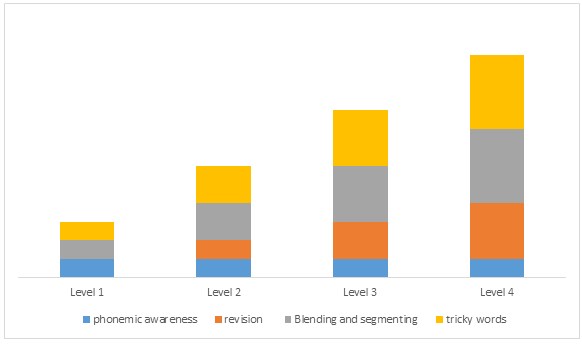
Teaching young learners in Cambodia
Cambodia's education is seeing a resurgence after years of war and famine. In many schools, however, teachers still work under conditions of severe resource limitations. With salaries less than US$200 a month and classes sometimes as large as 60 pupils, it is also not feasible for teachers to buy and distribute materials for each child in the class.
Under these conditions, finding colorful and tactile resources for the classroom is limited to whatever is freely available. Solid waste management is a growing concern in Cambodia, and garbage collection and disposal is currently still unreliable. As a result, there is a great deal of handy material available that can be recycled into the classroom for free. Our teachers had access to specific kinds of waste that were suitable and safe for classroom use, and these included plastic bottles (and their tops), ice-cream sticks, nut shells, old newspapers, clothing off-cuts from a garment factory, plastic plates and spoons, plastic and paper cups, and the like. The importance of ensuring that recycled material coming into the classroom is clean and safe was addressed as part of the workshops.
We present here a variety of the material designed for (and by) our Cambodian teachers, with some ideas on how they can be utilized in a classroom-based phonics program for each of the phonics skills. It is our hope that ideas like these can bring phonics into every young-learners classroom. In our examples here, the teachers had access to our color printer, but hand-drawn versions of the material could easily be substituted.
Recycled material for phonics instruction
A Phonemic awareness, segmentation and blending
1) Paper cups
We used two paper cups, one placed inside the other, with target graphemes printed on them. The cups are twisted to reveal letters and words (see Figure 1).
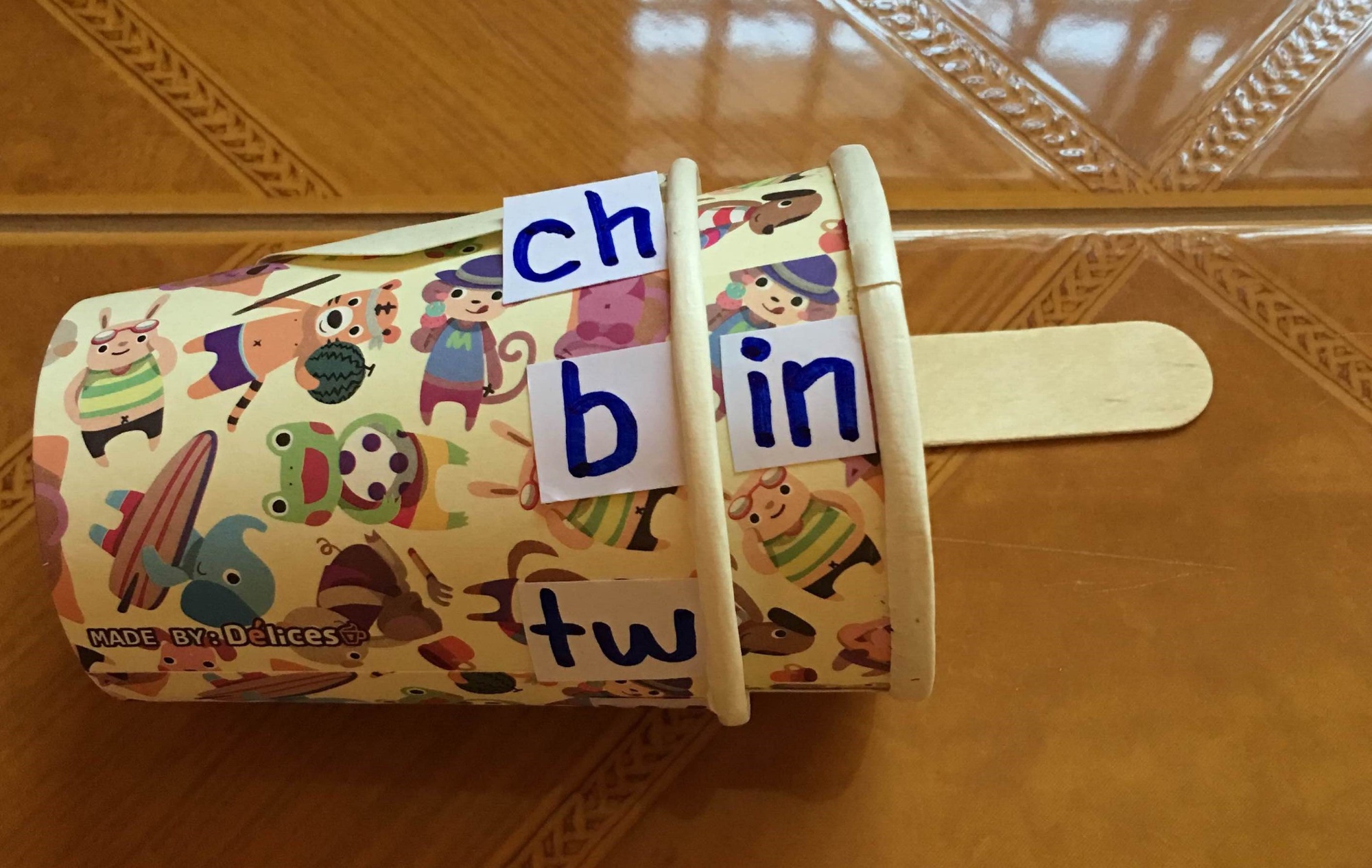
- Phonemic awareness: to develop the recognition of the individual sounds, students can place pictures of items they are familiar with (like ‘toy’) into the cup with the letter representing the (initial) sound of the word. In this way, learners identify individual sounds and match them with the associated symbol. Learners could work in pairs to ‘check’ one another’s matches.
- Segmenting: using the principle of a word family, on the inner cup print a suitable rime (for example ‘in’ in the example in Figure 1), and on the outer cup, a variety of matching onset letters (for example ‘ch’, ‘t’, ‘s’). The students can turn the cups to match the initial sound following a prompt from the teacher.
- Blending: again using the onset and rime combinations, learners twist the cups and read the resulting new words to a partner or transcribe onto paper.
2) Spoons
We wrote letters onto plastic spoons with a magic marker. With these, we were able to create a number of phonics activities.
- Phonemic awareness: the teacher (or another learner) calls out a sound and the learners identify the letter by holding up the correct spoon. A matching activity could be done with learners matching the spoon with a sound to a picture.
- Segmenting: learners match the onset of a word to the corresponding rime and substitute the spoons with each other to make a variety of words. Using ‘spoons in a pocket’ (see Figure 2), played individually or in pairs, learners find the corresponding spoons that match the word on the pocket. The pockets are old files folded and taped to fit the spoons
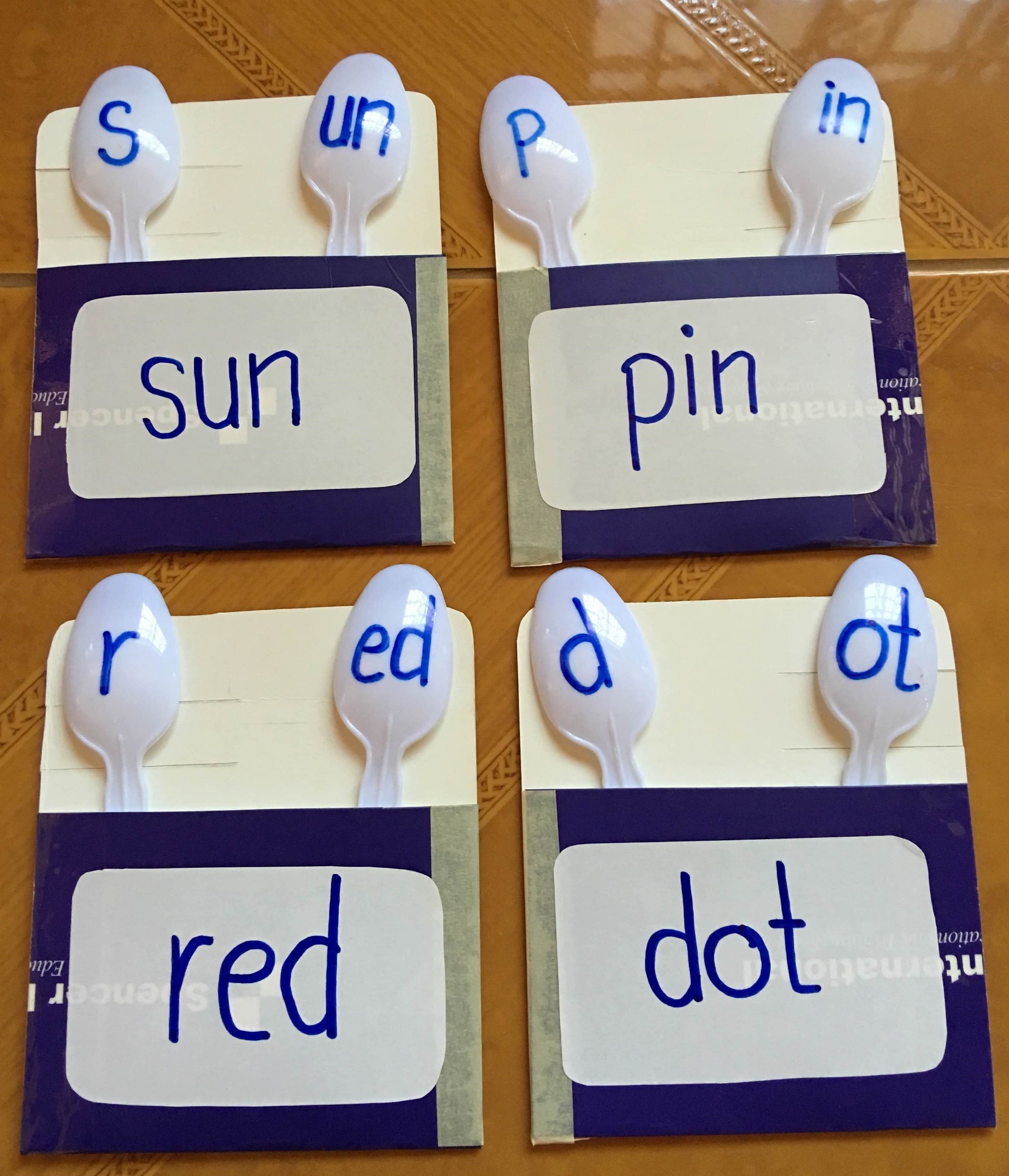
- Blending: learners use the sounds on the spoons to make CVC words by themselves. CVC words can be broken up into three or two parts (using onset and rime) depending on the development of the reader. For example: ‘bug’ can be divided into each grapheme ‘b’, ‘u’ and g’, or as ‘b’ and ‘ug’ for lower level readers (see Figure 3). Learners blend these sounds to make words could then be transcribed onto a fun surface like sand.
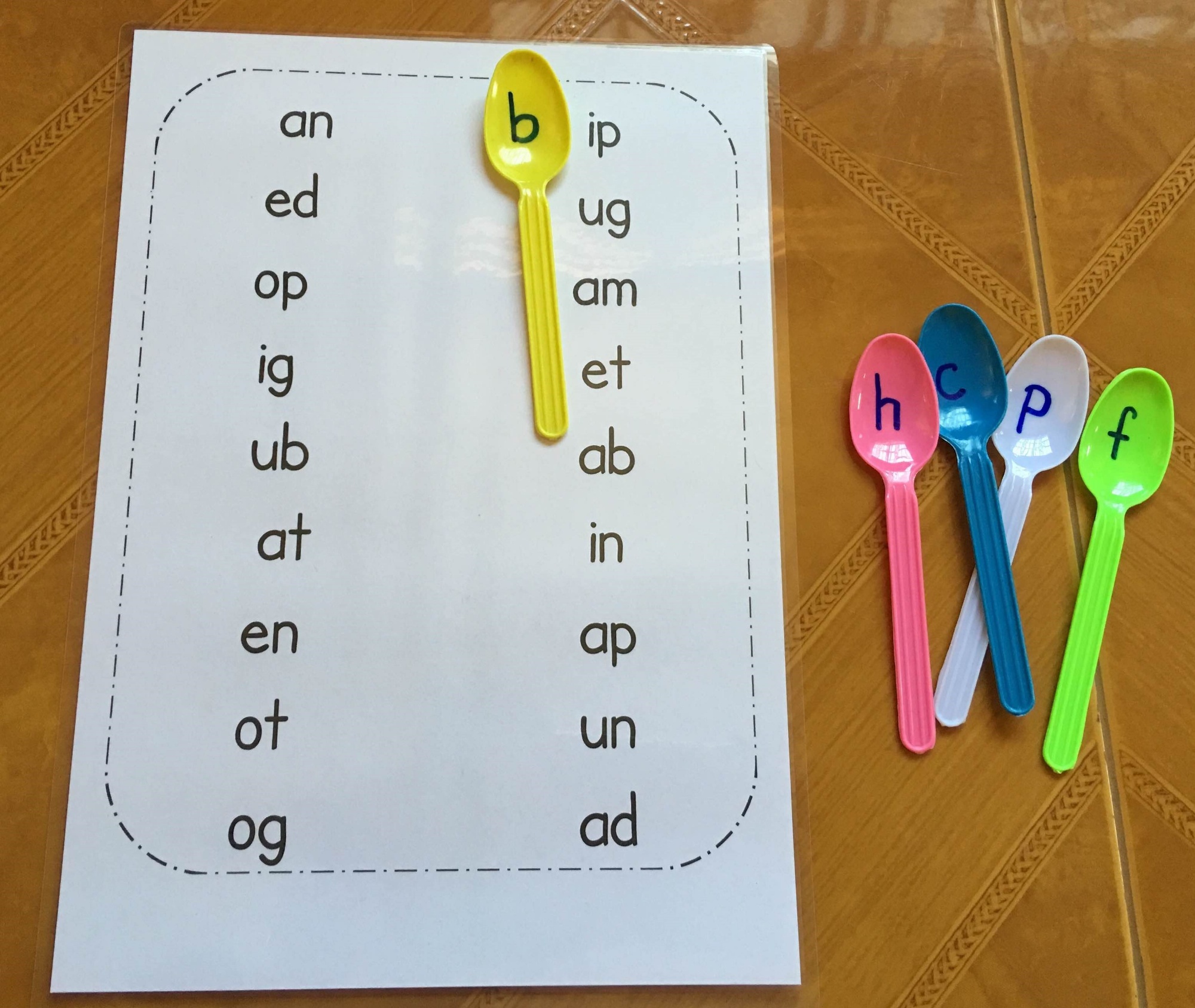
3) Bottle tops
Water bottles are always easily available and the tops are hardy when little hands work with them. A variety of activities could be designed to use both the inside and outside of the tops.
- Phonemic awareness: bottle tops are matched with the pictures of words that start with that sound. In the example in Figure 4, the pictures have been prepared by the teacher, but having the learners contribute by drawing pictures before the task would potentially increase student ownership of the task and learning materials.
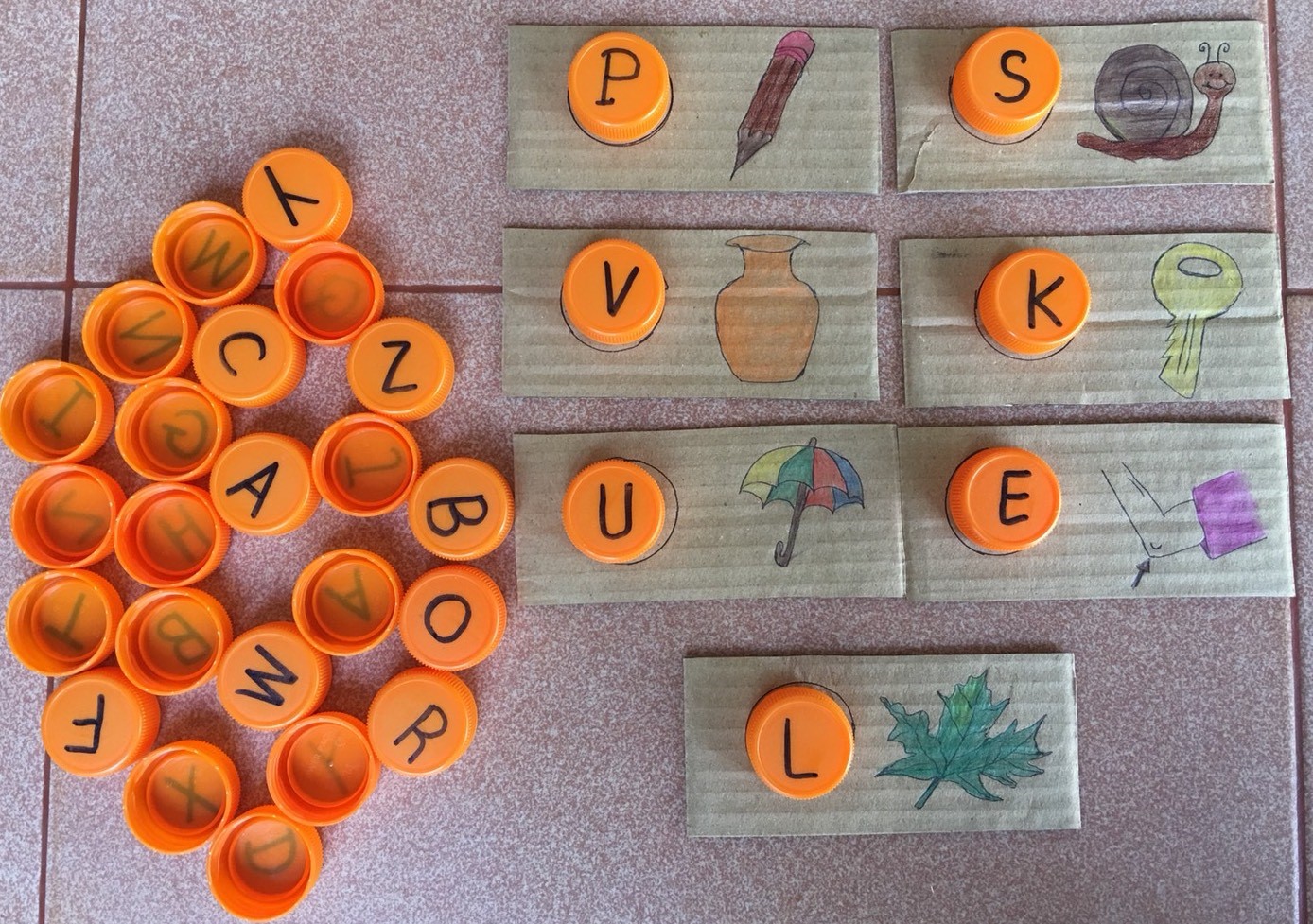
- Segmenting: we wrote the onset on off-cut pieces of card and the rime on the inside of the bottle tops (see Figure 5), however the cards could be substituted with bottle lids of another color. Learners match a card (onset) with the bottle tops (rimes) following a teacher's prompt. This activity encourages the learner to recognize the beginning and ending sounds of the words, as well as the sequencing of the sounds to make the word. Allowing the learners to match onsets to the rimes independently also activates blending skills.
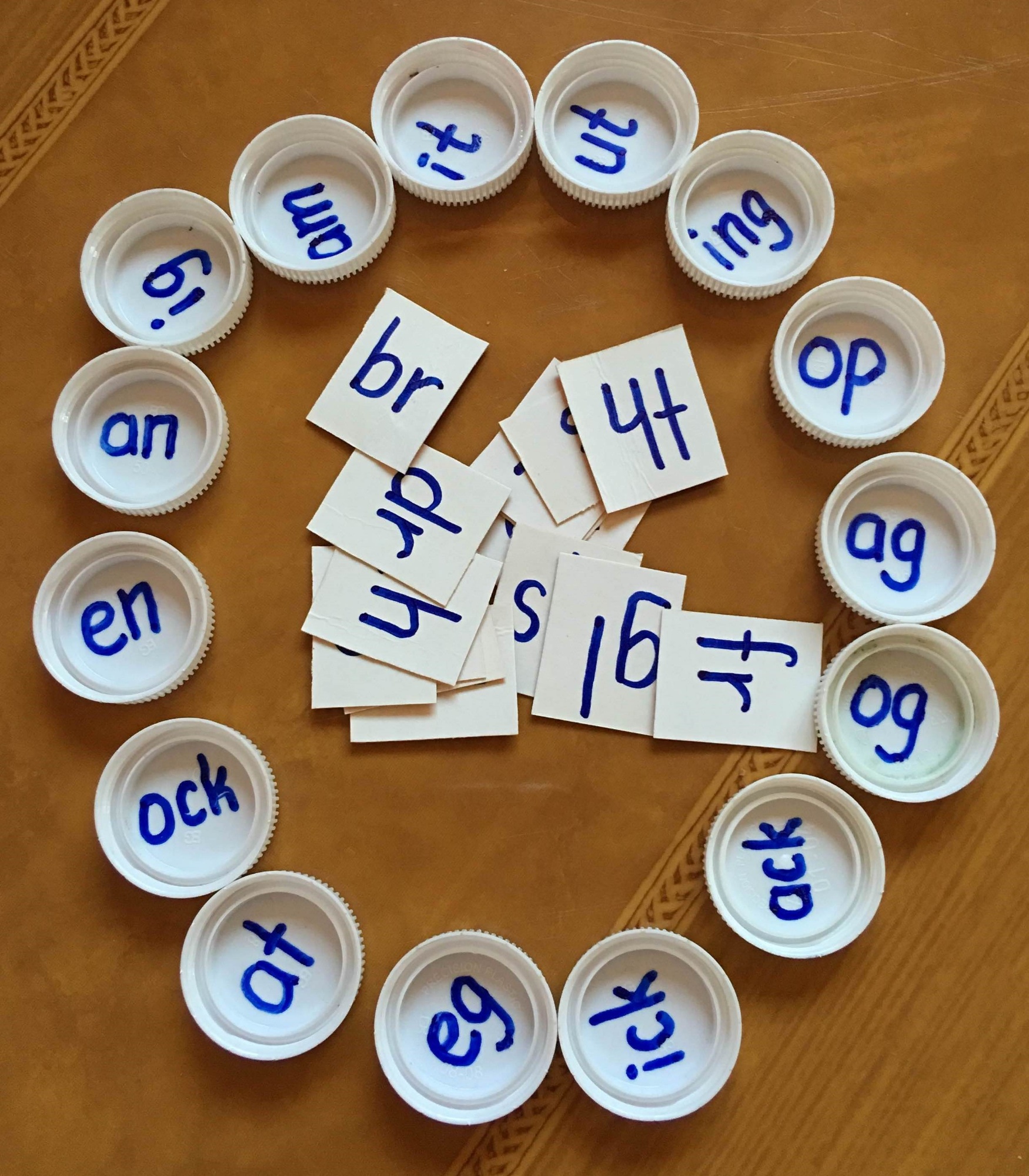
- Blending: individual sounds were written on discarded pistachio nut shells (but bottle tops and fast food restaurant tomato sauce cups also work). With these, we played ‘Make a word’, where the learners match sounds to make existing words. The ‘Make a Word’ activity has learners choosing beginning, middle and ending sounds to make their own words (see Figure 6). As a scaffold, the initial and final sounds could be written on different colored bottle tops (or in the inside rather than the outside of the nut shells). Once the readers are able to make as many existing words as possible, they write the words down on scrap paper, blackboards or in sand.
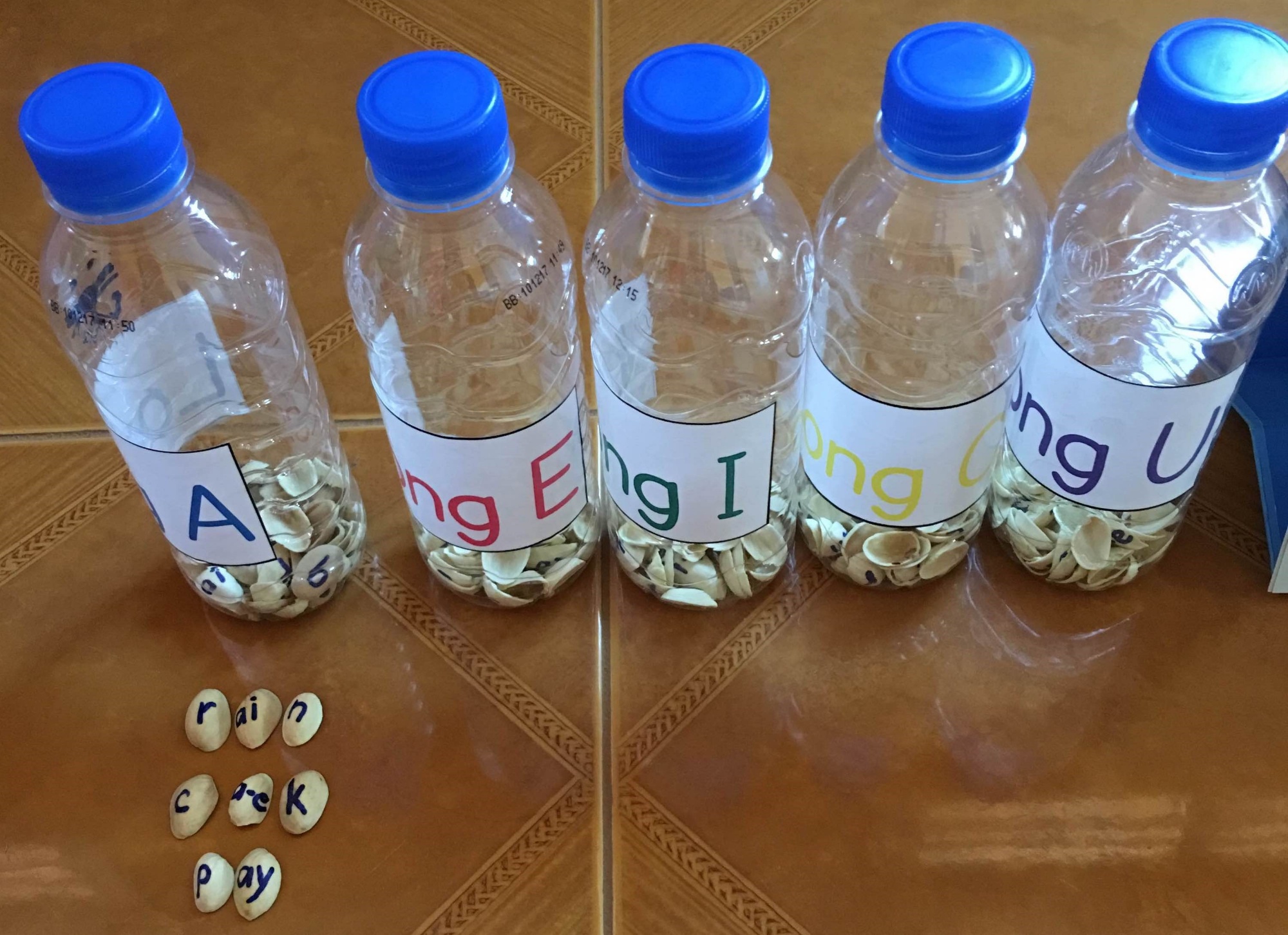
4) Cups and ice-cream sticks
For these activities we used paper or plastic cups, ice-cream sticks, and small off-cuts of card to draw pictures or sounds on. However, small pebbles, bottle tops, seeds, nut shells or buttons also work.
- Phonemic awareness: the sounds that are to be practiced are written on the side of the cup. The teacher calls out a sound and the learner throws an ice-cream stick (or similar) into the cup with the correct letter (see Figure 7). This can also be done in pairs with one learner looking at a picture and calling out the sound and the second learner throwing the stick into the cup with the matching sound. Adjusting the distance the objects are tossed according to the size of the cup and the ability of the learners can make the task more competitive.
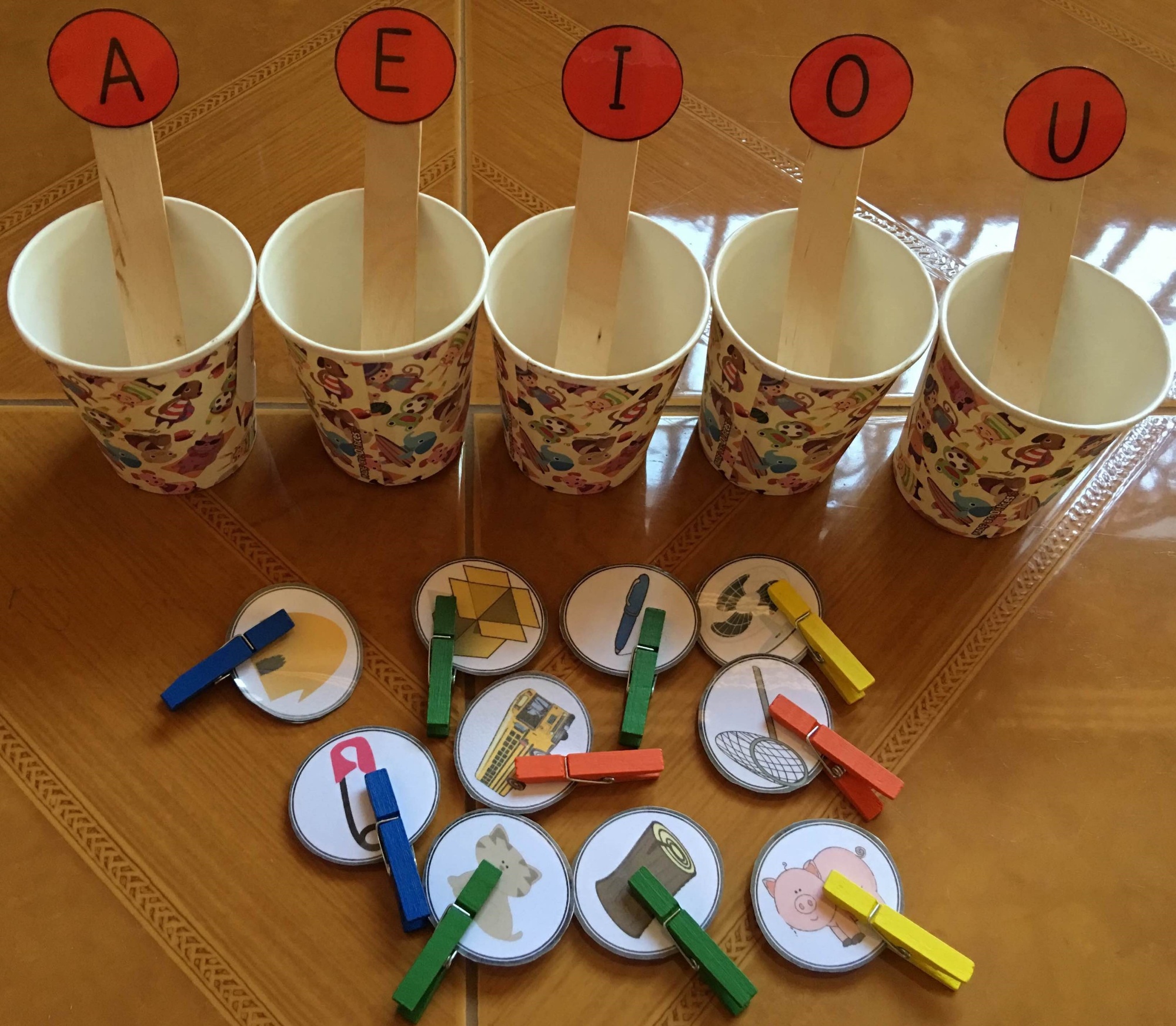
- Segmenting: on each cup, write the rime of a word family (‘at’ and 'ell' in the example in Figure 8). Learners place pictures on cards or words on ice-cream sticks into the corresponding cups (for example ‘cat’, ‘hat’ and so on). The pictures on the card could be color-coded for very young learners as a self-correction device. Older learners could do this activity in groups as a relay race.
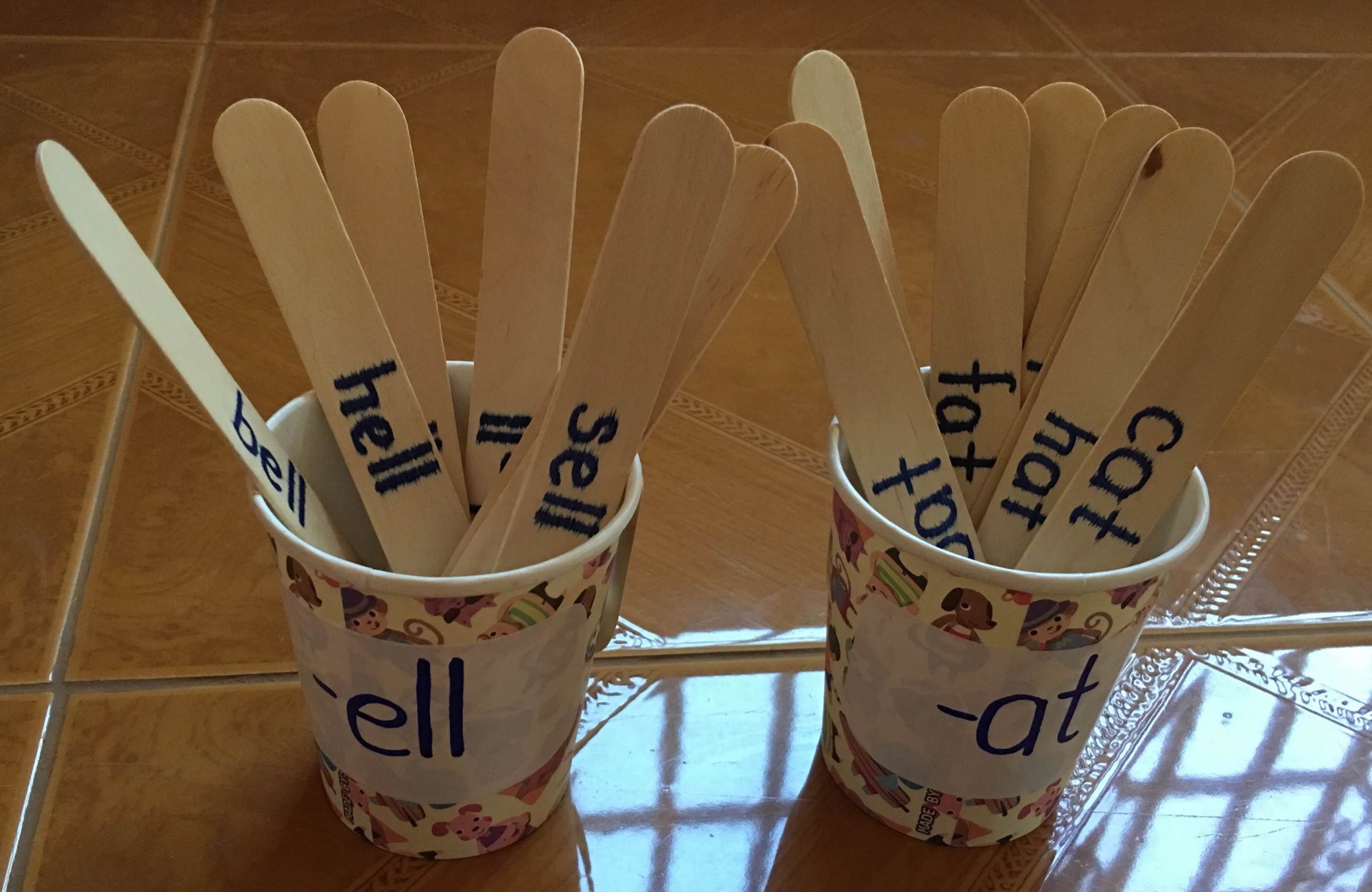
- Blending: a ‘Make a word’ activity can be set up with either the cups or the ice-cream sticks. Individual sounds are written on the bottom of the cups and turned upside down and the learners place three cups together to create CVC words. The word can then be transcribed onto a writable surface, such as paper, a blackboard, or sand.
5) Glove fingers
We had access to old gloves and the cut off fingers (see Figure 9). What was useful about this resource is that the learners could ‘wear’ the glove fingers, allowing the use of the learners’ fingers to help with the concept of breaking a word up into parts or putting the sounds together to make a word.
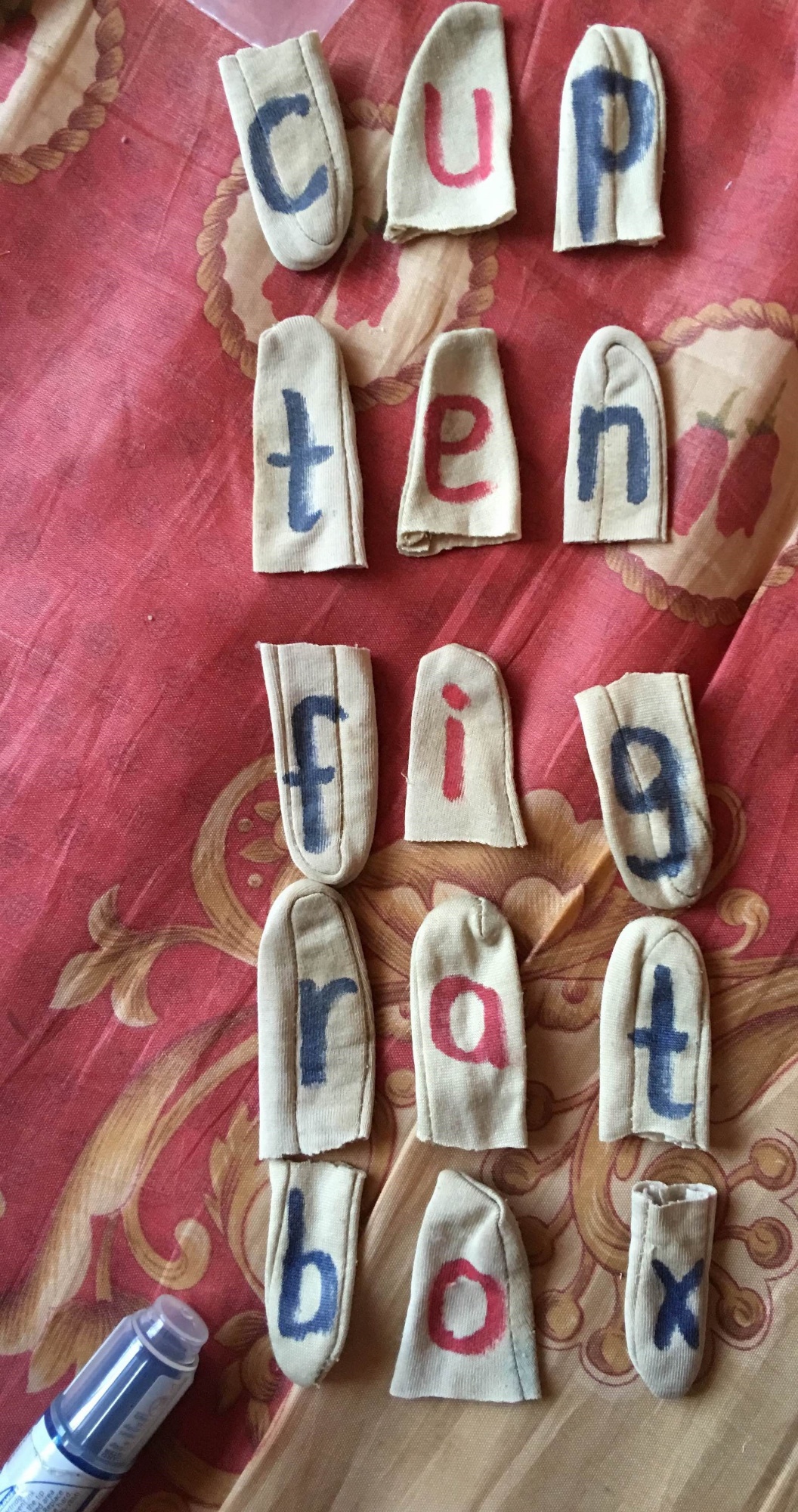
- Phonemic awareness: the learners each get five sounds and put them on their fingers. The teacher calls a sound and the learners with that sound would raise the correct finger. Older learners could play a game where they would ‘find’ a friend with the same sound as themselves.
- Segmentation: a learner chooses a CVC word and ‘wears’ the word on their fingers, in the correct sequence. The teacher (or a friend) can then ask what the beginning, middle or ending sound is of the word on their fingers and the learner would say and show that sound. A variation of this activity is to have the teacher (or friend) ask a learners which finger has a specific sound in a CVC word.
- Blending: in pairs or individually, learners have different sounds spread out in front of them, and the teacher calls out a CVC word for learner to place assemble on their fingers.
B Sight words
To help memorize sight words, drilling activities that encourage the continual use and recognition of these words is crucial. We present two activities here as examples of how to expose learners to these words and help memorize them.
1) ‘Sight word finger football’
This activity has learners reading the sight word written on bottle tops, and in turns trying to flick them into the 'goal'. We found a children's toy to use as the goal, but an old plastic waste-paper basket cut in half also works well.
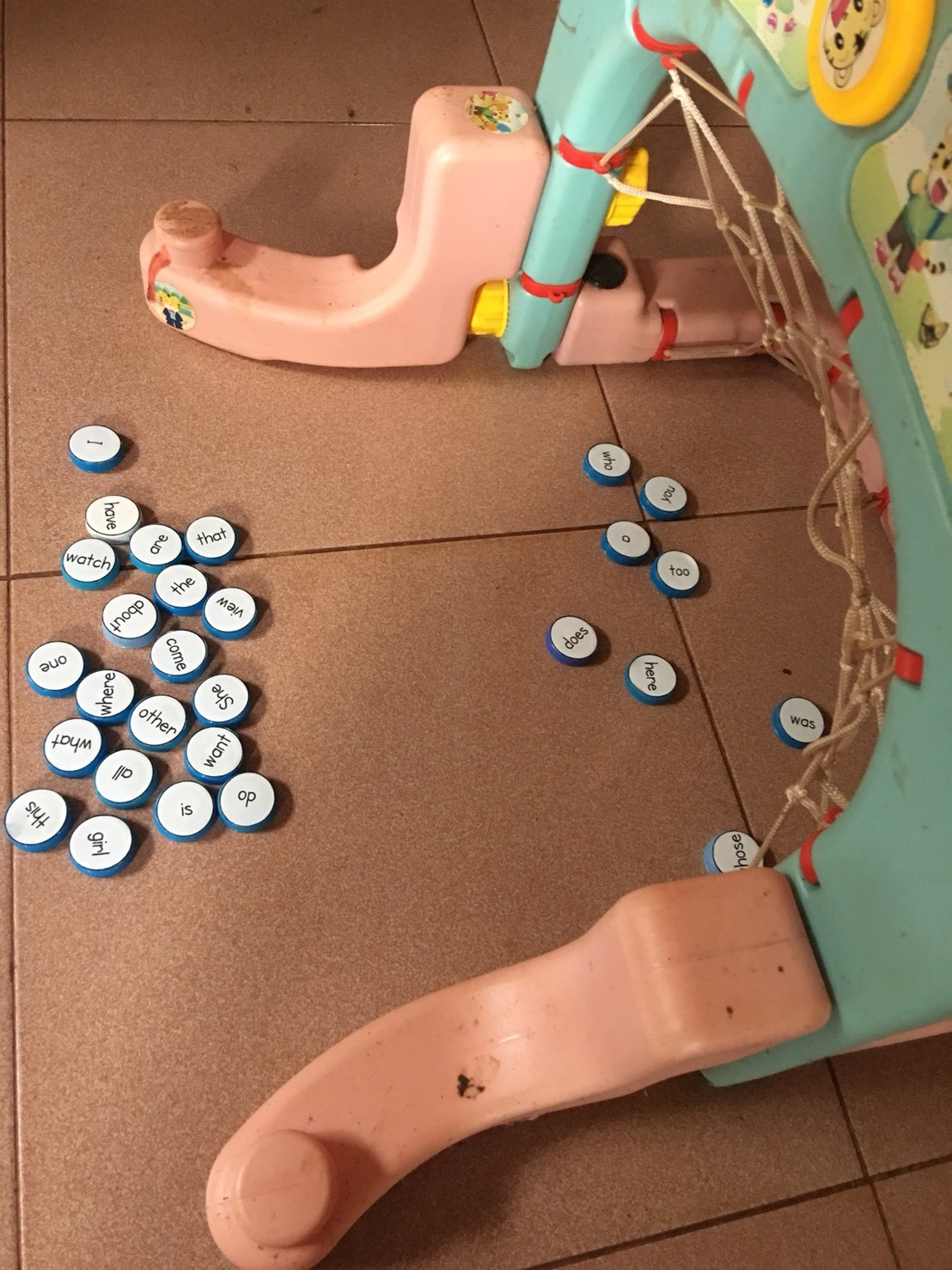
2) Sight word bingo
This is a traditional bingo game with learners working individually, in pairs or even divided into small groups of four. Each group of learners gets about ten sight words written on bottle tops or ice-cream sticks. The teacher calls out a word and the learners turn that bottle lid or ice-cream stick upside down. The first group to have all their words turned is the ‘winner’.
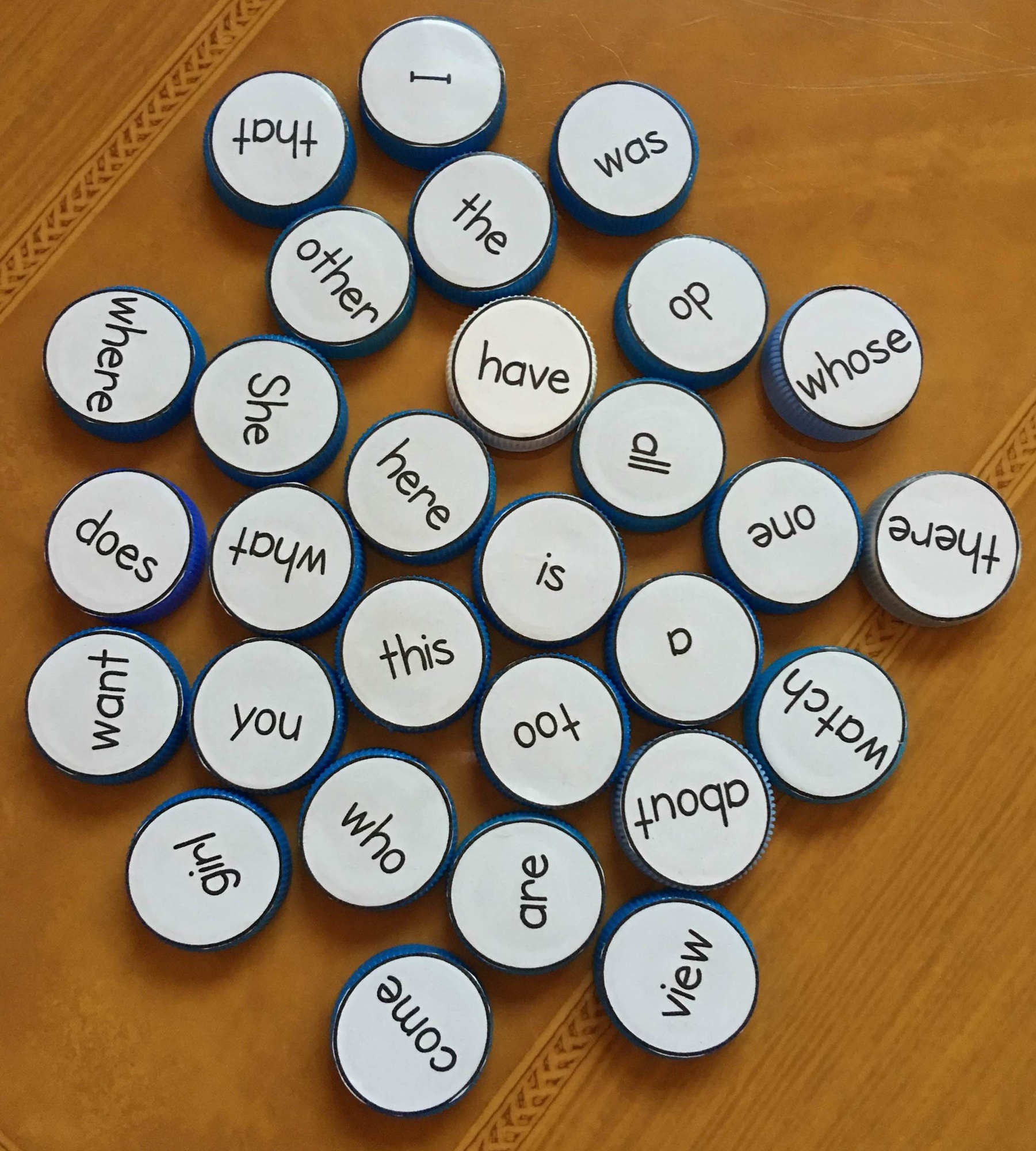
Conclusion
A lack of funds, or the problems created for teachers in a resource-impoverished environment need not undermine the goals of achieving colorful, tactile and creative lessons and activities. In our work in Cambodia, once teachers started seeing the benefit of these materials in action, we were impressed with their individual creative efforts as they produced a variety of other phonics games (see figures 12 and 13).
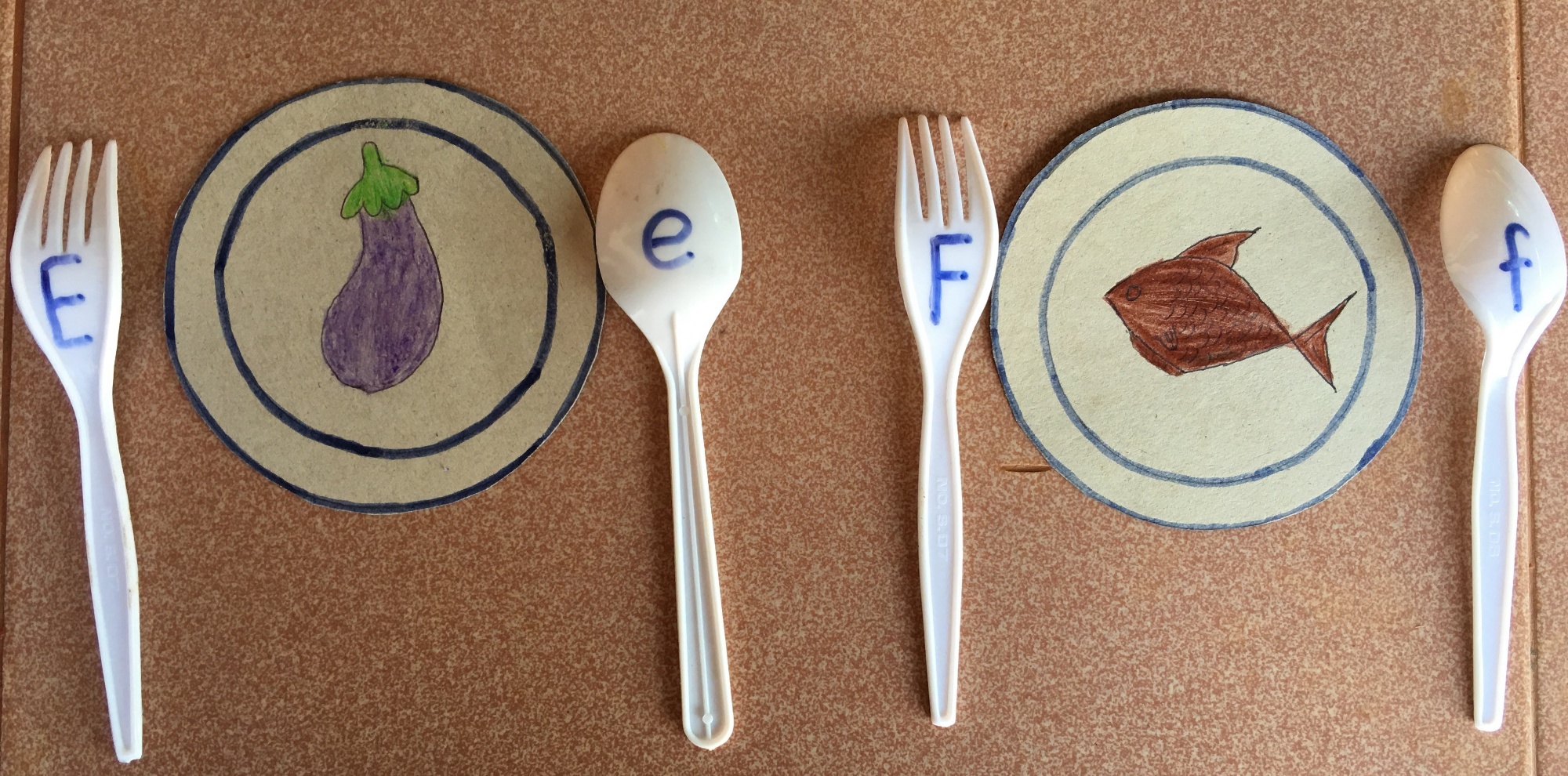
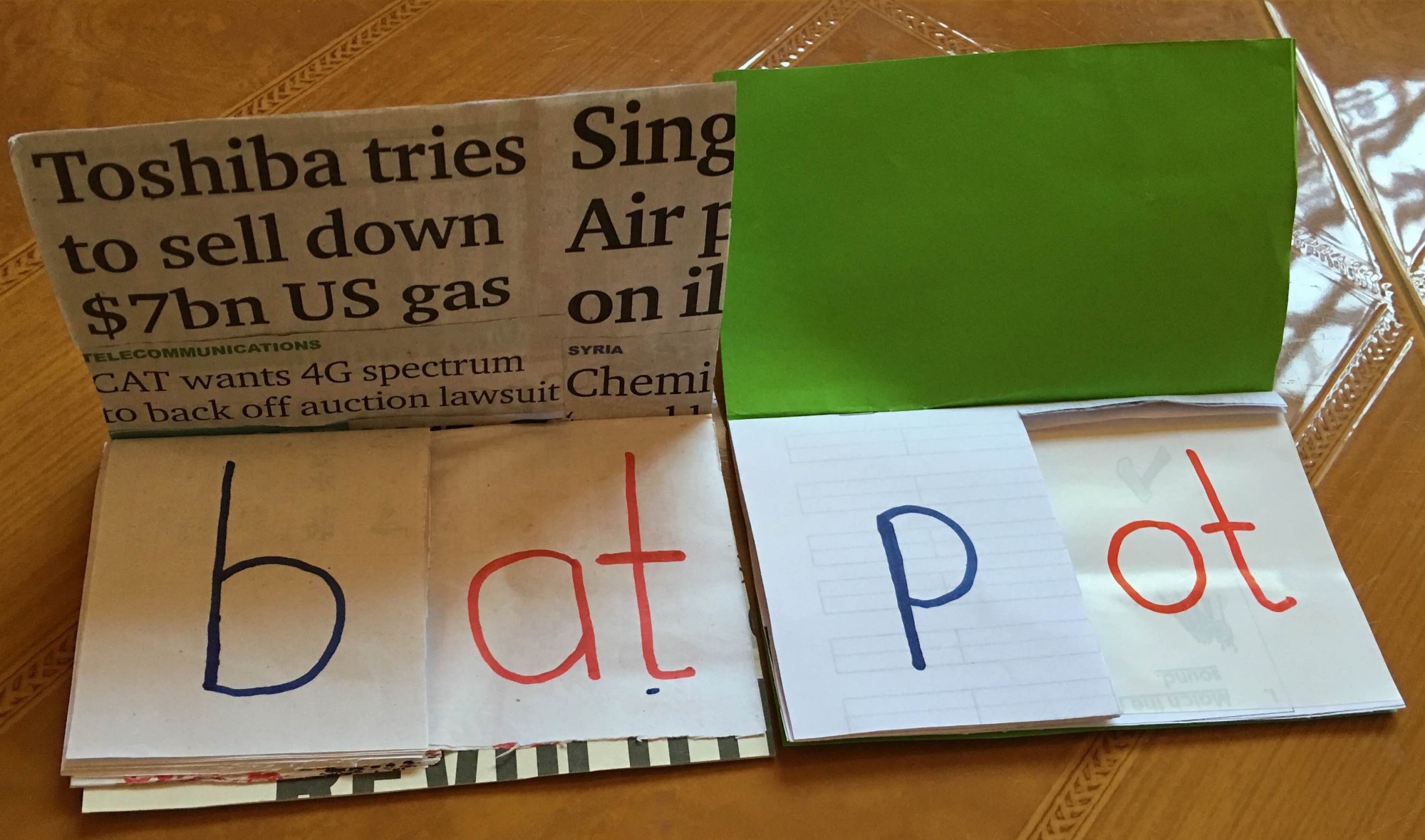
Not only that, but the material also stood the test of classroom-based use, and a report like this would be incomplete without some indication of the materials' successful implementation with the learners. In Figure 14, children in a rural school in Siem Reap province demonstrate the utility and durability of these locally produced materials.

Utilizing recycled material helps keep costs low, and creates ownership as learners get involved to help collect materials to make the activities. As a final benefit of this approach, the use of recycled material in the classroom enhances environmental sensitivity, a much needed focus in developing countries such as Cambodia.
References
Adams, M. J. (2004). Why not phonics and whole language. Literacy: Major themes in education, 2, 193-220.
Amato, N. (2015) A lack of resrouces for many classes, New York Times, March 26, http://www.nytimes.com/roomfordebate/2015/03/26/is-improving-schools-all-about-money/a-lack-of-resources-for-many-classrooms
Benveniste, L., Marshall, J., & Araujo. M.C. (2008). Teaching in Cambodia. Human Development Sector, East Asia and the Pacific Region, World Bank, https://openknowledge.worldbank.org/bitstream/handle/10986/8073/448500WP0Box3210KH0Teachers11Final1.pdf
Cheung, H., McBride-Chang, C., & Tong, X. (2011). Learning a nonalphabetic script and its impact on the later development of English as a second language. In A. Y. Durgunoğlu, & C. Goldenberg (Eds.), Language and literacy development in bilingual setting (pp. 168–187). New York, NY: Guilford Press.
Fox, B.J. (2000) Word identification strategies: Phonics from a new perspective (2nd ed.). Upper Saddle River NJ., Prentice-Hall.
Goswami, U. (2005). Synthetic phonics and learning to read: a cross‐language perspective. Educational Psychology in Practice, 21(4), 273-282.
Jones, S.A. & Deterding, P. (2007) Phonics and Beginning Reading: A Practical Guide for Teachers in Southeast Asia. Singapore, McGraw-Hill.
Morrow, L.M. & Tracey, D.H. (May, 1997), Strategies Used for Phonics Instruction in Early Childhood Classrooms. The Reading Teacher, 50(8), pp. 644-651
Lloyd, S., Wernham, S., Jolly, C., & Stephen, L. (1998). The phonics handbook. Chigwell: Jolly Learning.
National Reading Panel (US), National Institute of Child Health, & Human Development (US). (2000). Report of the national reading panel: Teaching children to read: An evidence-based assessment of the scientific research literature on reading and its implications for reading instruction: Reports of the subgroups. National Institute of Child Health and Human Development, National Institutes of Health. https://www1.nichd.nih.gov/publications/pubs/nrp/Documents/report.pdf
Pelli, D. G., & Tillman, K. A. (2007). Parts, wholes, and context in reading: A triple dissociation. Plos One, 2(8), e680.
Rose, J. (2005). Independent review of the teaching of early reading: Interim report. Department for education and skills. http://image.guardian.co.uk/sys-files/Education/documents/2005/12/01/interimreport.doc last accessed 16 May 2016.
Stahl, S. A., Duffy-Hester, A. M., & Stahl, K. A. (1998). Everything you wanted to know about phonics (but were afraid to ask). Reading Research Quarterly, 33, 338–355.
Wyse, D., & Styles, M. (2007). Synthetic phonics and the teaching of reading: the debate surrounding England's ‘Rose Report’. Literacy, 41(1), 35-42.
Ziegler, J. C., & Goswami, U. (2005). Reading acquisition, developmental dyslexia, and skilled reading across languages: a psycholinguistic grain size theory. Psychological bulletin, 131(1), 3-29.
Please check the Creative Methodology for the Classroom course at Pilgrims website.
Please check the Methodology and Language for Primary course at Pilgrims website.
Phonics for Free: Using Recycled Materials in Resource-impoverished Schools
Sunee Steyn, Thailand;Stephen Louw, Thailand;Thoeun Malin, CambodiaA School Day in a Village in Nepal
Annette Kurz, Germany